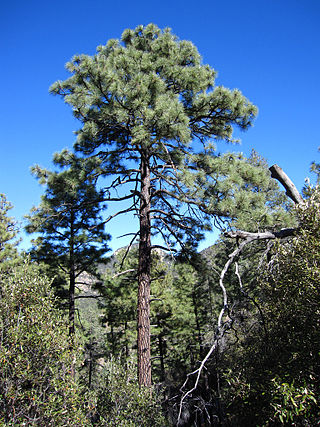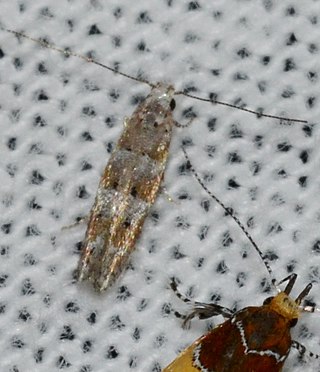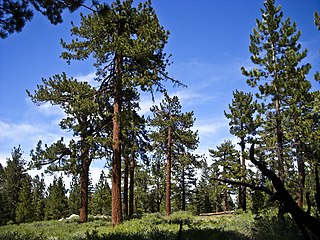
Pinus jeffreyi, also known as Jeffrey pine, Jeffrey's pine, yellow pine and black pine, is a North American pine tree. It is mainly found in California, but also in the westernmost part of Nevada, southwestern Oregon, and northern Baja California. It is named in honor of its botanist documenter John Jeffrey.

Coulter pine, or big-cone pine, is a native of the coastal mountains of Southern California in the United States and northern Baja California in Mexico. Isolated groves are found as far north as Clearlake, California on the flanks of Mt. Konocti and Black Diamond Mines Regional Preserve. It is named after Thomas Coulter, an Irish botanist and physician. The Coulter pine produces the heaviest cone of any pine tree, up to 5 kg (11 lb) and among conifers is exceeded only by the cones of Araucaria bidwillii.

Pinus arizonica, commonly known as the Arizona pine, is a medium-sized pine in northern Mexico, southeast Arizona, southwest New Mexico, and western Texas in the United States. It is a tree growing to 25–35 m tall, with a trunk diameter of up to 1.2 m. The needles are in bundles of 3, 4, or 5, with 5-needle fascicles being the most prevalent. This variability may be a sign of hybridization with the closely related ponderosa pine. The cones are single, paired, or in whorls of three, and 5–11 cm long.

Pinus ponderosa, commonly known as the ponderosa pine, bull pine, blackjack pine, western yellow-pine, or filipinus pine is a very large pine tree species of variable habitat native to mountainous regions of western North America. It is the most widely distributed pine species in North America.

Pinus engelmannii, commonly known as the Apache pine, is a tree of Northern Mexico, in the Sierra Madre Occidental with its range extending a short distance into the United States in southwestern New Mexico and southeastern Arizona. This pine is a medium-sized species with a height of 20–30 metres and a trunk diameter of 35–80 centimetres.

Exoteleia is a genus of moths in the family Gelechiidae.

The ponderosa pine needleminer is a moth of the family Gelechiidae. It is found in the United States, where it has been recorded from Colorado.
Coleotechnites ponderosae, the ponderosa pine needleminer, is a moth of the family Gelechiidae. It is found in the United States, where it has been recorded from Colorado.
Coleotechnites edulicola is a moth of the family Gelechiidae. It is found in North America, where it has been recorded from New Mexico and southern Utah and possibly Colorado.

Exoteleia pinifoliella is a moth of the family Gelechiidae. It is found in eastern North America.

Exoteleia dodecella, the pine bud moth, is a moth of the family Gelechiidae. It is widely distributed from western Europe to Siberia. It is an introduced species in North America.
The flora of the Colorado Plateau and Canyonlands region is generally characterized by plant adaptations to the arid conditions of the region, and a wide variation of plant communities from wide variations in elevation and soil types. The elevation variation results in temperature variation. Differing soil types are largely due to erosion of different sedimentary layers in the canyons, from the layers at lowest point of canyons of the Colorado River network, to the top layers of the plateau. Exceptions to flora adapted to aridity occur in lowland riparian areas, at springs, and in hanging gardens.
Coleotechnites canusella, the banded jack-pine needleminer moth, is a moth of the family Gelechiidae. It is found in North America, where it has been recorded from British Columbia, Washington, Alabama, Arizona, Louisiana, New Mexico and South Carolina.
Coleotechnites chillcotti is a moth of the family Gelechiidae. It is found in North America, where it has been recorded from Alabama, Louisiana, Maryland, New Jersey, Pennsylvania and South Carolina.
Exoteleia burkei, the Monterey pine shoot moth, is a moth of the family Gelechiidae. It is found in North America, where it has been recorded from California.
Exoteleia californica is a moth of the family Gelechiidae. It is found in North America, where it has been recorded from California.
Exoteleia nepheos, the pine candle moth, is a moth of the family Gelechiidae. It is found in North America, where it has been recorded from southern Ontario and northern Ohio.
Exoteleia succinctella is a moth of the family Gelechiidae. It is found in the Alps, on the Balkan Peninsula and in Bulgaria.

In ecology and forestry, yellow pine refers to a number of conifer species that tend to grow in similar plant communities and yield similar strong wood. In the Western United States, yellow pine refers to Jeffrey pine or ponderosa pine. In the Southeastern United States, yellow pine refers to longleaf pine, shortleaf pine, slash pine, or loblolly pine. In the United Kingdom, yellow pine refers to eastern white pine or Scots pine. In New Zealand, it refers to Halocarpus biformis.









